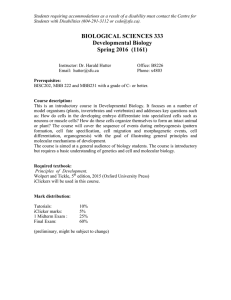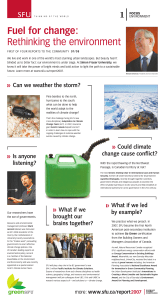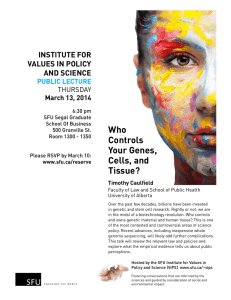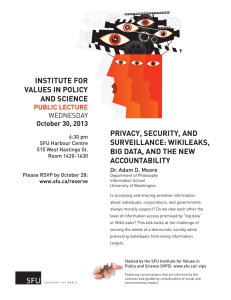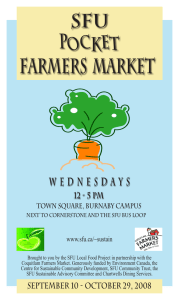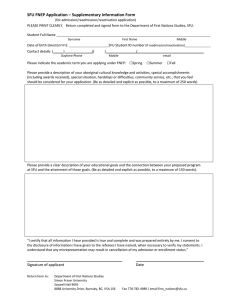BIO-BULL Welcome from the Chair
advertisement
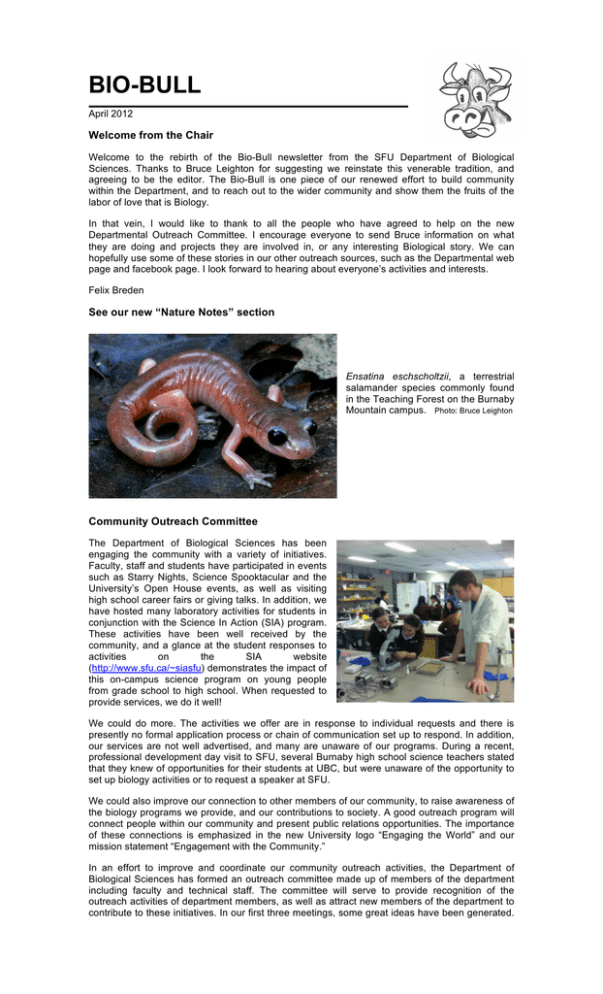
BIO-BULL April 2012 Welcome from the Chair Welcome to the rebirth of the Bio-Bull newsletter from the SFU Department of Biological Sciences. Thanks to Bruce Leighton for suggesting we reinstate this venerable tradition, and agreeing to be the editor. The Bio-Bull is one piece of our renewed effort to build community within the Department, and to reach out to the wider community and show them the fruits of the labor of love that is Biology. In that vein, I would like to thank to all the people who have agreed to help on the new Departmental Outreach Committee. I encourage everyone to send Bruce information on what they are doing and projects they are involved in, or any interesting Biological story. We can hopefully use some of these stories in our other outreach sources, such as the Departmental web page and facebook page. I look forward to hearing about everyone’s activities and interests. Felix Breden See our new “Nature Notes” section Ensatina eschscholtzii, a terrestrial salamander species commonly found in the Teaching Forest on the Burnaby Mountain campus. Photo: Bruce Leighton Community Outreach Committee The Department of Biological Sciences has been engaging the community with a variety of initiatives. Faculty, staff and students have participated in events such as Starry Nights, Science Spooktacular and the University’s Open House events, as well as visiting high school career fairs or giving talks. In addition, we have hosted many laboratory activities for students in conjunction with the Science In Action (SIA) program. These activities have been well received by the community, and a glance at the student responses to activities on the SIA website (http://www.sfu.ca/~siasfu) demonstrates the impact of this on-campus science program on young people from grade school to high school. When requested to provide services, we do it well! We could do more. The activities we offer are in response to individual requests and there is presently no formal application process or chain of communication set up to respond. In addition, our services are not well advertised, and many are unaware of our programs. During a recent, professional development day visit to SFU, several Burnaby high school science teachers stated that they knew of opportunities for their students at UBC, but were unaware of the opportunity to set up biology activities or to request a speaker at SFU. We could also improve our connection to other members of our community, to raise awareness of the biology programs we provide, and our contributions to society. A good outreach program will connect people within our community and present public relations opportunities. The importance of these connections is emphasized in the new University logo “Engaging the World” and our mission statement “Engagement with the Community.” In an effort to improve and coordinate our community outreach activities, the Department of Biological Sciences has formed an outreach committee made up of members of the department including faculty and technical staff. The committee will serve to provide recognition of the outreach activities of department members, as well as attract new members of the department to contribute to these initiatives. In our first three meetings, some great ideas have been generated. We have begun building an inventory of our resources and a community outreach link on the department web page. The department has much to offer the community, and our performance of these activities has been outstanding. With better communication and coordination, along with faculty and staff willing to oversee the program, our outreach activities could be more effective in connecting with the community. Outreach will build public support, interest more people in biology and recruit great students. Peter Hollman Connections We have updated the information on our website, www.biology.sfu.ca/. New content includes two videos that link from the website highlighting our graduate program: one on Cells, Molecules and Physiology and one on Evolution, Ecology. From the website you also will see links to our YouTube movie channel including the videos and more; http://www.youtube.com/user/sfubiology/videos and Facebook page http://www.facebook.com/pages/SFU-Biology/126440294101656. We hope the Facebook page will help build community among present and past members of the Department of Biological Sciences. The Bisgrove Lab Born and raised in BC, Dr. Sherryl Bisgrove returned home in 2006 after completing degrees at UVic, IU and the U. of Utah and signed on with the department. Her lab is studying developmental biology in plants, examining how plants respond to their environment. As plants cannot get up and walk away from adverse conditions, they find other means to adjust to their surroundings. A driving force in their ability to adapt lies in their microtubule behaviour. Present in all eukaryotes, microtubules have vital roles in plants, controlling cell expansion, cell division and the directional growth of roots. Currently, the Bisgrove lab is focused on how microtubules affect the growth and directionality of developing roots. How do plant roots know to grow down, and how do they know which direction to go when they encounter an obstacle such as a rock? By examining Arabidopsis mutants for the reactions of their roots to mechanical and gravitational stimuli, Sherryl and her MSc students Shannon Squires and Saeid Shahidi (Photo: Melanie Hart) seek to answer some of the numerous questions that remain unanswered about microtubular mediated growth. One component of this research is highlighted in a recent paper by Sherryl’s former MSc student, Laura Gleeson published in Plant Science: http://www.sciencedirect.com/science/article/pii/S0168945212000209 The exciting results continue, with Saeid furthering work begun by Sherryl’s former post-doc Robin Young, and Shannon set to defend her MSc later this year. Melanie Hart Staff Achievement Award For laboratory technician Fan Sozzi-Guo, the announcement that she’d won the Staff Achievement Award for Personal Achievement came as a complete surprise. Those who’ve had the opportunity to interact with Fan agree that the award couldn’t have gone to a more deserving person; she brings a delightful sense of humour, amazing organizational skills and a dedicated work ethic to a job that can have a person running all day. Fan has been a member of the biology department for eight years, joining us at SFU after she moved with her husband to Burnaby from Switzerland. Over the years, she has been the technician for Peter Hollman’s BISC Microbiology course, Fan with daughter Morgain Toxicology with Russell Nicholson, and Gene Cloning with Jim Mattson, to name a few. True to the spirit of the teamwork among the biology department’s technicians, Fan acknowledges that her award is one to be shared with her coworkers: “Without the support of the team, I could not be nominated and could not achieve everything I did.” Biology is truly fortunate to have Fan with us; her amazing attitude, hard working nature, and general enthusiasm make her an integral part of the department. Melanie Hart News Jonathan Moore joined the Department as the Liber Ero Chair in Coastal Studies. His research focuses on conservation and management issues. Jonathan joins our internationally acclaimed Earth2Oceans (E2O) group. We gratefully acknowledge Val and Dick Bradshaw for establishing the Liber Ero Chair at SFU and for opening opportunities to collaborate with Liber Ero Chairs at McGill and UVic. John Reynolds, the Tom Buell BC Leadership Chair in Salmon Conservation, another member of E2O, recently testified at the Cohen Commission on Fraser River Sockeye Salmon, which has been in the news a lot. John’s dedication to informing the public on conservation of BC Salmon and BC Ecosystems won him the SFU President’s Award for Service through Public Affairs and Media Relations last year. Bernie Crespi was elected as a Member of the Royal Society of Canada. Previous members of the Department elected to the Royal Society include John Borden, Larry Dill and Mark Winston. This recognizes Bernie’s lifetime work in evolutionary biology and behavioral ecology; lately he has been applying these ideas to explain the genetic basis of psychiatric diseases such as autism and schizophrenia. As reported in the New York Times and Vancouver Sun (they compared him to Freud), his ideas have great potential to revolutionize our understanding of these diseases and to suggest new therapies Achievements and Awards Ben Sandkam and Corey Watson have won Best Poster in the Environment and Ecology category at the AAAS conference in Vancouver Marlene Nguyen is one of two winners of the Dean of Graduate Studies Awards for Excellence in Service and Bernie Roitberg is one of two winners of the two Dean of Graduate Studies Awards for Excellence in Graduate Student Supervision. Gordon Rintoul received a Parkinson Society Canada Pilot Project Grant, which is a new direction for Gordon’s lab. Mark Winston worked for many years on bee communication within the Department and since 2002 has been Director of SFU's Wosk Centre for Dialogue at the downtown SFU campus. Last year the joint meeting of the Entomological Society of Canada and Entomological Society of BC in Vancouver honoured his work on bee communication and human communication with a Symposium “Mark Winston Retrospective: Travels in the World of Bees, Pollination and Communication.” Julian Guttman will receive the Morphological Sciences Award from the American Association of Anatomists, and present an award lecture at the AAA annual meeting next year. Rolf Mathewes has been awarded the 2011 Outstanding Alumni Award for Academic Achievement. Rolf was nominated not only for his exceptional service to the University, including 10 years as Associate Dean of Science, but also for his stellar contributions to Paleoecological research in BC. On top of that, Rolf is a charter alumnus of SFU, having received a B.Sc. From Biological Sciences in 1969, so he is a perfect fit for the award. More Media Attention Bruce Archibald, a post-doctoral associate with Rolf Mathewes, reported on “A giant ant growing over 5cm (2in) long that crossed the Arctic during hot periods in the Earth's history. The ant, named Titanomyrma lubei, lived about 50 million years ago and is one of the largest ant species ever found.” This article was featured on the front page of BBC websitehttp://www.bbc.co.uk/news/science-environment-13269302 Rolf and Bruce's story then made it into CBC's list of top science stories in 2011. http://www.cbc.ca/news/technology/story/2011/12/19/f-science-top-stories-2011.html Nick Dulvy’s group summarized extinction risk for 1,568 species in 16 families of marine animals portrayed in the movie Finding Nemo. The piece attracted a lot of attention, and such clever ways of presenting conservation research can do a lot to influence public perception and policy. The original paper was published in Conservation Letters http://onlinelibrary.wiley.com/doi/10.1111/j.1755-263X.2011.00206.x/abstract Jenn Sunday from FAB*-Lab and Earth to Oceans, a PhD student in Mike Hart's lab, reported at the International Marine Conservation Congress on the genetic parameters controlling the ability of marine organisms to adapt to ocean acidification. This research was highlighted in Nature News. http://blogs.nature.com/news/2011/05/adapting_to_an_acid_ocean.html Aboriginal Training program funding renewed by Merck: In 2010, The Biology Department initiated a program for Training Aboriginal Youth in Biomedical Labs (TAYBL), and we just received funding from Merck Canada for another year. Aboriginal students are greatly under-represented in the health and biomedical sciences, and this program is designed to provide such students with entry-level training in a biomedical lab on the Burnaby campus along with the mentorship and sense of community that comes with working in a lab as an undergraduate. Nature Notes Owl Invasion! The biggest birding story of the winter season has undoubtedly been the invasion of the region by large numbers of Snowy Owls. This irruptive migration has been by far the largest in recent history, with dozens of these beautiful white birds being visible at any one time at Boundary Bay and other winter birding hotspots around the Lower Mainland. Snowy Owls, arguably the largest owl found in North America, can weigh in at a whopping 2.7 kg, with an average mass of 1.7 kg. They are fearsome predators, with massive feathered talons capable of snuffing the life out of a snowshoe hare, although they have a varied diet including everything from lemmings to seabirds. In large part, their numbers are probably tied to the seasonal and multi-year fluctuations in their main prey, the various species of lemmings. When these rodents enter a low phase of their cycle, the owls must fly further south to survive the winter. This implies that owls appearing locally are not just enjoying a vacation in our balmy southern climes, but rather are more akin to desperate refugees from a famine. As such, they may be especially vulnerable to stresses such as harassment by humans and pets. Sofi Hindmarch, an owl specialist with the Canadian Wildlife Service in Delta BC, encourages birders to get out and see the owls at Boundary Bay, but to maintain a respectful distance: “Approaching the owls closely causing them to flush could have a major negative effect on these birds. Please respect the owls’ space and watch from the dike rather than following them out into the wetlands”. Photos and article: Sean McCann Previous editions of Bio-Bull can be found at http://www.sfu.ca/biology/biobull Editorial Staff: Bruce Leighton, Leslie Dodd, Melanie Hart and Dave Carmean
